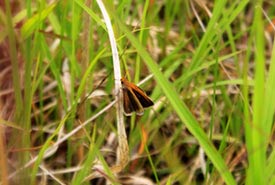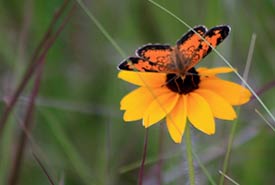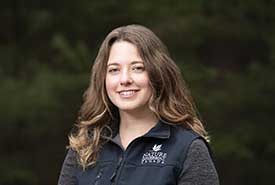Butterfly moments

Poweshiek skipperling (Photo by NCC)
"Just living isn't enough," said the butterfly, "one must also have freedom, sunshine, and a little flower."
~ Hans Christian Anderson
Sometimes a place speaks to you. You may not even consciously notice it until you find yourself thinking of it often, looking back through photos and memories, or even until you find yourself there again and it just feels right.
In the past few years, I’ve made the move from Manitoba to Alberta. In Alberta, I have found several new “places.” I feel it while watching the moose and waterfowl in the Cooking Lake Moraine, or revelling in the beauty where the prairie meets the mountains in Waterton.
However, there is one place from my home province that gets me every time; the Tall Grass Prairie Natural Area in southeastern Manitoba.
This past spring I received a call from Cary Hamel, conservation science manager for the Manitoba Region of the Nature Conservancy of Canada (NCC), and my former boss. NCC in Manitoba had received funding to do rare species surveys on some of their lands in the Tall Grass Prairie— more specifically surveys for Poweshiek skipperling. He asked if I would be interested in coming back to Manitoba for a week in July and do the Poweshiek surveys for NCC.
Now this little orange butterfly was the subject of my master's thesis and research for several years, and is a bit of a passion project for me. I had been recently missing my summers of chasing butterflies, and was excited about the prospect of getting to do it for a week. Luckily, I work for a great organization like NCC, which allowed the Alberta and Manitoba regions to collaborate on this undertaking.
With my workplan in Alberta covered for the week, I made the trek back to Manitoba.
After meeting with the Manitoba staff and collecting my equipment, I headed south down Highway 59 from Winnipeg. I have probably made that drive more than 200 times in my life. My first real biologist job was helping a master student study the western prairie white-fringed orchid while I was doing my undergraduate degree, plus three seasons of field work for my own masters and various trips in between with other jobs.
From the highway, it honestly doesn’t look like much — the mosaic of aspen bluffs, sedge meadow wetlands, upland areas of big bluestem and other tall grasses that give the area its name all blend together in a blur while going 100 kilometres per hour. However once you pull down one of the gravel grid roads, park and head into nature, then you really appreciate what is out there.

Northern crescent butterfly (Photo by NCC)
An incredible diversity of plants, birds and insects, a vibrant mix of habitat types and microsites all alive with the sounds of the creatures that live there.
With 1,400 kilometres of travel behind me, the real work began. I settled in at the Weston Family Tall Grass Prairie Interpretive Centre, my home for the next several days, and started mapping out all of the sites to look for the Poweshiek skipperling.
NCC has done considerable work in the past to compile known sites from other surveys (including my masters work), in addition to using the known habitat indicators to flag potential habitat sites.
Each site was methodically checked with butterfly net in hand (in case a closer look at a butterfly) was warranted. The first few days came up empty, with a few potential sightings, but nothing confirmed. That always causes one to worry — are we too late? Too early? Are they all gone? Have I lost my butterfly chasing touch?
Luckily, those worries were for naught, because on the third day we had a confirmed Poweshiek skipperling!
The next day we had even more, and pictures to prove it. The remaining days continued to prove fruitful, as many of the known sites surveyed still hosted Poweshiek skipperling.
It is only through the collaboration of NCC (across the country in this case), academics (Richard Westwood at the University of Winnipeg is a partner in these surveys), various levels of government funding and other conservation partners in the Tall Grass Prairie Preserve that this work can be done.
Surveys such as this one are critical to the ongoing survival of the species. They allow NCC and other land managers in the area to ensure that management practices are compatible with the skipperling and other endangered species, allows further collaboration and study with Universities and zoos in the area be providing population and habitat data, and gives us an idea of how to better enhance the habitat and the hopes of survival.
As I started the 15-hour drive back home to Alberta, I couldn’t help but feel lucky that I was able to work for an organization like NCC, and that NCC conserves many of these special places that get under your skin.
You can look back on some of the daily adventures from my field work by checking out #posk #ncclive on twitter.
“The butterfly counts not months but moments, and has time enough.”
Rabindranath Tagore


